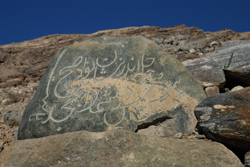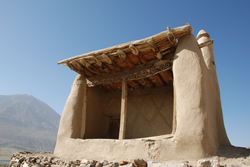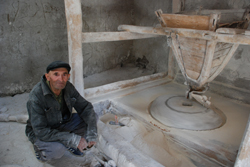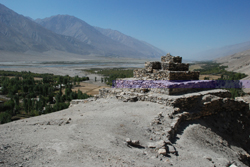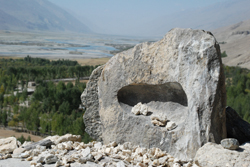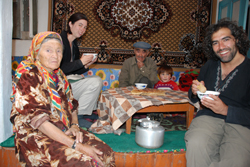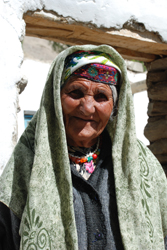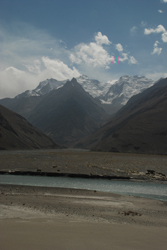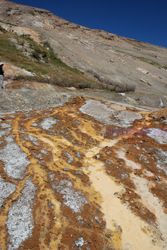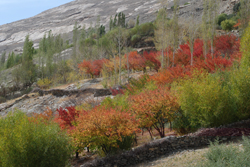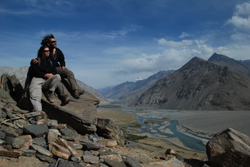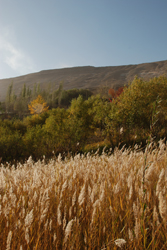Wakhan Trip Day 4: Yamg to Lenger
22 September, 2008, 04:21 pm in "Tajikistan"

In the morning, Hadar's son led us to Mubarak's last chilehane. It was a short way from the museum and I think the opening had been blocked with a huge stone. Above it was a black stone with Mubarek's inscription in Persian on it. From the stone, we had a perfect view of the tomb against the clear blue morning sky. We climbed up to the tomb, decorated with curved sheep horn patterns. From there we had a view of the valley and mountains, some with deep cracks. Haydar had told Rowshan that the Russians had built an irrigation system that pumped the water up the hill so it could irrigate the hillside. After they left, it couldn't be maintained so now it is gone.
From Yamg, it was a short drive to Vrang. On the way to the Buddhist stuppa, we were joined by some kids. One girl pointed out the town mill. It was water powered. The water was guided into a building where it powered a heavy grinding stone. The whole inside of the building was covered with flour.
From there we hiked up to the stuppa. It was so strange to see it because it seems so out of place after seeing all the borderline animistic Islamic shrines. It was a square based pyramid built of stones on the hillside. On top was a stone with a rounded indentation. All around it was small white stones so it looks like it has retained some sacred or superstitious significance... or tossing stones in the indentation was a local kids game.
Back down the hill, we stopped by the bazaar looking for bread. The bazaar had very little for sale. Though it had lots of space for people to sell food, there was only one stall with tea, sugar, some cookies and candies. Since everyone makes their own bread, no one sells it. However a man offered to take us to his house where he would give us some. He led us through town to his house where he and his wife served us milk tea which I think is similar to Tibetan butter tea. It is tea with milk but with salt instead of sugar. It made me think a bit of oatmeal without the oats. The bread was some of the tastiest we've had and they gave us a huge half round, apologizing that it wasn't fresh since they had had no electricity for several days. Rowshan tried to pay them and the man put up a fight. Rowshan finally stuck money in his pocket, twice. This is a common problem faced by travelers in the Pamirs. People here are so generous and quick to offer food or a place to stay, yet have so little. Some travelers take advantage of the generosity... maybe because they don't understand the dire situation many of the people here are in.
After Vrang, we stopped by some hot springs. I didn't go in but Rowshan took a hot spring shower where the water flowed out of an outdoor pool and dropped into a rusty colored swamp which seeped into the river. I sat watching the mountains, river and sheep. The colors of the area are so harmonious-- the gray blue of the river, rusty gold of the plants, burnt orange of the pools, and blue of the sky.
As we were driving out of one town, we saw a kid who instead of waving as we went by, ran back a little farther from the road even though he was on an embankment safely out of harms way. Zaher explained that when he was little, his father and other parents would tell the kids that if they stood too close to the road, the cars would take them away to Osh where they would be fattened up and eaten. “Ah... that's why the laghman in Osh was so good,” I joked. Zaher said, in this area, the parents still used the story to keep the kids out of the street.
We passed the Zala-i-Panja on the Afghan side of the river and came to the town of Zong where the remains of the Abreshim Qala rested high on the top of a hill. It was a steep walk and the remains weren't too impressive. However, the view made the walk worth while. There were several impressive peaks in Afghanistan--one, a white pyramid. The valley seemed to split creating a space which revealed peaks beyond. Through the mountain gap, where one part of the river flowed and more mountains rose to border the other part of the river. Below the fort was an orchard of trees whose leaves had turned fiery red. Below the mountains spread a flood plain, startling in its flatness at the foot of such high peaks.
We passed the Zala-i-Panja on the Afghan side of the river and came to the town of Zong where the remains of the Abreshim Qala rested high on the top of a hill. It was a steep walk and the remains weren't too impressive. However, the view made the walk worth while. There were several impressive peaks in Afghanistan--one, a white pyramid. The valley seemed to split creating a space which revealed peaks beyond. Through the mountain gap, where one part of the river flowed and more mountains rose to border the other part of the river. Below the fort was an orchard of trees whose leaves had turned fiery red. Below the mountains spread a flood plain, startling in its flatness at the foot of such high peaks.
[ View 1 Comments
|
]
Comments
michelle tavakoli -
posted on 3/23/2009
THE SALT LAKES/STREAMS AND THE HIGHWAY REMIND ME OF DRIVING ON HIGHWAY 80 BY UTAH/SALT LAKE CITY WITH MY BOYFRIEND AT THE TIME FARHANG IN 1979 AND IN NEVADA.


